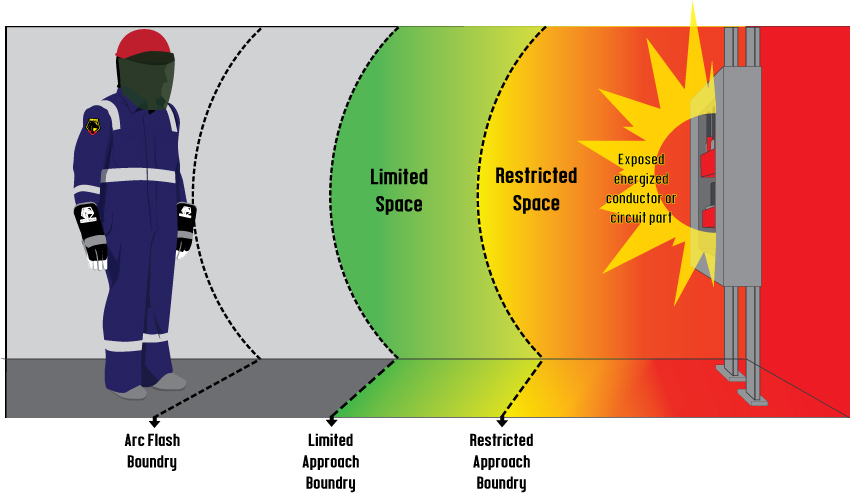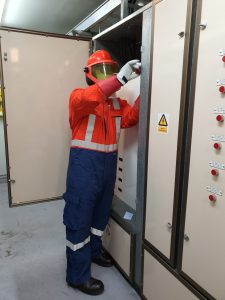Arc Flash
An Arc Flash is an electrical explosion due to a fault or short circuit where electric discharge travels through the air between conductors or from a conductor to a ground. An Arc Flash can last anywhere from a fraction of a second to several seconds.
Most 400v and above electrical machinery has the capacity to cause an Arc Flash.
When an Arc Flashes happens they create a very bright light and intense heat and have the potential to create an arc blast. Arc Blasts and the resulting heat can lead to fires, pressure waves and flying shrapnel that result in serious damage to people and property. These explosions generally occur without any warning.
The arc blast will travel towards a ground of some type. The exact distance an arc flash can travel is known as the arc flash boundary. This is determined by the potential energy present and a variety of other factors including air temperature and humidity.

Image Source: http://badgerstateconsulting.com/

Potential causes of Arc Flash
An Arc Flash can be caused by a wide range of reasons but often the cause will be a damaged piece of equipment such as a wire. It could also be the result of someone working on a piece of equipment that makes it possible for electricity to escape from its normal path.
Electricity will follow the path of least resistance, so an arc flash will not necessarily occur as soon as a piece of equipment is damaged, instead it will continue to work as normal until another path with less resistance becomes available.
Things that can create a path with lower resistance include:
- Dust – in dusty areas electricity may be passing outside the wiring or other equipment through the dust.
- Dropped tools – if a tool is dropped on a wire, it can damage it and allow electricity to pass into the tool, from there it can find another path to travel.
- Accidental touching – if a person touches a damaged area – the electricity can flow through their body or at least out of its normal path.
- Condensation – when condensation forms, electricity can escape wiring and travel through the water.
- Material failure – if a wire is damaged to the point where the electricity has trouble passing through, there may be less resistance for it to go outside the wire.
- Corrosion – corrosion can create a path outside the wire.
- Faulty installation – if equipment is installed incorrectly it can make it difficult for electricity to follow the intended path.
Protecting against Arc Flash
To minimise the risk of an Arc Flash occurring your plant should identify where the biggest dangers are. Anywhere in a facility where high electrical current can exist should be properly labelled with arc flash warnings. Regular checks of all high voltage equipment and wiring should also be done to make sure there is no sign of corrosion, damage to wires or any other issues. Key areas to focus on include electrical switchboards, panels, socket enclosures and motor control centres.
When a machine does need to be worked on it should be completely de-energised. Not just switched off but shut down and physically disconnected from any power source. Once this is done a voltage check should be done to ensure there is no latent energy stored up.
If a machine cannot be de-energised while working on it, head-to-toe PPE should be worn to prevent serious injury. As per the NFPA70 standards (do you want to hyperlink to these?), arc flash boundaries should be clearly marked so anyone working within these areas is aware of the need to wear PPE.
Circuit breakers should be installed in all machines. These ensure that if a sudden surge in electricity is detected it will stop the flow immediately. Circuit breakers cannot stop arc flashes occurring but can ensure they only last a fraction of the time. If your machines do not have these in place, the arc flash will continue until the electricity is physically stopped; either by someone cutting the power or the damage from the arc flash stopping the flow of electricity.
At EAS, our team is experienced in working in hazardous areas. If you need assistance to ensure that you have taken all the necessary precautions to reduce the risk of Arc Flash in your plant or need support from a team of knowledgeable experienced industrial electricians – give the team at EAS a call on 07 834 0505.


Leave a Reply
Want to join the discussion?Feel free to contribute!